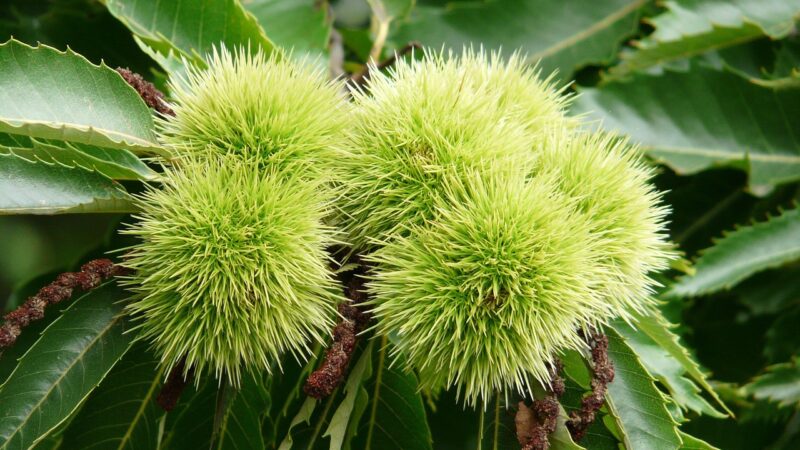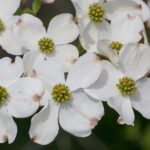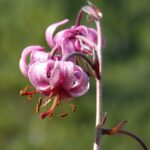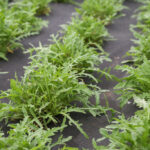Wintering of the sweet chestnut

Successfully guiding a sweet chestnut tree through the winter months is a crucial aspect of its year-round care, especially for younger trees and in climates that experience harsh winter conditions. The dormant season, while a period of rest, presents its own set of challenges, from freezing temperatures and desiccating winds to damage from snow, ice, and hungry wildlife. Proper winter preparation is not about fighting nature, but about working with the tree’s natural cycle of dormancy to provide protection and ensure it emerges in spring healthy, undamaged, and ready for a new season of vigorous growth.
The primary goal of winter care is to mitigate the potential damage caused by environmental stressors. For young trees with thin bark and less-established root systems, protection from extreme cold and sunscald is paramount. As the tree matures, the focus may shift to protecting its structure from the weight of heavy snow or ice and ensuring its root system is not subjected to repeated freezing and thawing cycles. The strategies employed will therefore vary depending on the age of the tree and the specific climate of the region, requiring a thoughtful and adaptive approach from the grower.
Winter is also a time to protect the tree from animal damage, which can be particularly severe when other food sources are scarce. Rodents like voles and mice can girdle the base of young trees by chewing on the bark under the cover of snow, while rabbits and deer can cause significant damage to the trunk and lower branches. Implementing physical barriers and other deterrents before the winter sets in is a non-negotiable step in safeguarding your investment and ensuring the young tree’s survival through its most vulnerable stage.
Ultimately, the process of wintering a sweet chestnut is about proactive preparation during the autumn months. This involves ensuring the tree enters dormancy in a healthy and well-hydrated state, cleaning up the surrounding area to reduce pest and disease pressure for the following year, and putting protective measures in place before the first hard freeze arrives. By taking these steps, you provide your tree with the best possible conditions to endure the rigors of winter, setting the stage for a strong and healthy start when the growing season resumes in spring.
Preparing the tree for dormancy
The transition into winter dormancy begins in the autumn, and the care you provide during this period is critical for the tree’s ability to withstand the cold months ahead. One of the most important steps is to ensure the tree is adequately hydrated before the ground freezes. If the autumn has been dry, provide several deep, thorough waterings to saturate the root zone. A well-hydrated tree is much more resilient to winter desiccation, a condition where the tree loses water through its bark and buds to dry winter winds when it cannot replace it from the frozen ground. This final watering is a crucial step in winter preparation.
More articles on this topic
As the growing season winds down, you should cease all fertilization by late summer. Applying fertilizer, especially those high in nitrogen, late in the season can encourage a flush of new, tender growth. This new growth will not have enough time to properly harden off and mature before the first frosts arrive, making it extremely susceptible to being killed by the cold. Allowing the tree to naturally slow its growth and respond to the shortening days and cooler temperatures is essential for it to develop maximum cold hardiness and enter a state of deep dormancy.
Good sanitation around the base of the tree in the autumn is a vital practice for preventing future pest and disease problems. It is essential to rake up and remove all fallen leaves, nuts, and spiny burrs from under the tree. This debris can provide a perfect overwintering habitat for fungal spores, such as those that cause leaf spot diseases, and for the pupae or larvae of insect pests like the chestnut weevil. By cleaning the area thoroughly, you are significantly reducing the source of potential infections and infestations for the following spring, giving your tree a cleaner, healthier start to the new growing season.
Finally, conduct a thorough inspection of the tree before winter truly sets in. Look for any dead, damaged, or diseased branches that could be a potential hazard during winter storms. While major structural pruning is best left for the late dormant season, removing any obvious weak or broken limbs can prevent them from tearing off and causing larger wounds under the weight of snow or ice. This pre-winter check-up allows you to identify any potential issues and address them before they become more serious problems during the harsh winter months.
Protecting young trees from cold and sun
Young sweet chestnut trees, with their thin, smooth bark, are particularly vulnerable to winter damage and require specific protection during their first few years. The two primary threats are extreme cold, which can damage the living tissues of the trunk and branches, and sunscald, which is a significant risk even in moderately cold climates. Sunscald occurs on sunny winter days when the low-angled sun warms the south and southwest-facing sides of the trunk, causing the cells to become active. When the sun sets or goes behind a cloud, the bark temperature plummets rapidly, killing these active cells and causing the bark to crack and split open.
More articles on this topic
To protect against both sunscald and extreme cold, it is highly recommended to wrap the trunks of young trees. You can use commercial tree wrap, which is a crepe-like paper material, or plastic spiral guards. Start at the base of the tree and wrap upwards in an overlapping spiral to a point just above the lowest set of branches. The wrap should be snug but not so tight that it constricts the trunk. This layer of insulation protects the bark from rapid temperature fluctuations and provides a physical barrier against the cold. The wrap should be applied in late autumn and removed promptly in the spring to prevent it from harboring moisture and pests.
Another effective method for preventing sunscald is to paint the trunk with a white, water-based latex paint diluted with an equal amount of water. The white color reflects the sunlight, preventing the bark from absorbing excessive heat and thus keeping its temperature more stable throughout the day. This is a common practice in commercial orchards and is a very effective and low-cost solution. Paint the trunk from the soil line up to the first set of main branches. This should also be done in the autumn on a dry, mild day.
In addition to protecting the trunk, it is important to protect the root system of young trees, which is less extensive and closer to the surface than that of mature trees. Applying a thick layer of organic mulch, about 10-15 centimeters deep, around the base of the tree will help to insulate the soil. This mulch layer moderates soil temperature, preventing the deep freezing and repeated freeze-thaw cycles that can damage roots. Be sure to pull the mulch back a few centimeters from the trunk itself to prevent moisture buildup against the bark, which could encourage disease or provide cover for rodents.
Managing snow and ice loads
While sweet chestnuts generally have a strong wood structure, heavy accumulations of snow and ice can put immense stress on their branches, potentially leading to breakage and significant damage. This is a particular concern with wet, heavy snow or during freezing rain events that can coat every twig and branch in a thick layer of ice. The weight can become so great that it exceeds the load-bearing capacity of the wood, causing limbs to crack or split away from the main trunk. Proactive and reactive measures can help to minimize this type of winter damage.
During a heavy snowfall, if it is safe to do so, you can periodically go out and gently brush the snow off the branches of smaller, younger trees. Use a soft broom or a pole to gently push upwards on the branches, dislodging the snow. Never shake the tree or pull down on the branches, as this can cause them to snap, especially when they are cold and brittle. For larger, mature trees, this is often not practical or safe, and you must simply let nature take its course, which highlights the importance of having performed proper structural pruning in previous seasons to remove weak or poorly attached branches.
Ice storms present a more dangerous and difficult challenge, as the ice is bonded firmly to the branches and cannot be easily removed. It is extremely important that you do not attempt to break the ice off the branches. The branches are frozen and incredibly brittle, and trying to remove the ice will almost certainly result in more damage than the ice itself would have caused. It is best to wait for the ice to melt naturally. If a branch does break, it is better to leave the jagged stub until the storm has passed and the weather improves, at which point you can make a proper, clean pruning cut to facilitate healing.
After a severe winter storm has passed, it is important to inspect your trees for damage. Look for any broken or cracked branches that are still hanging in the tree, as these are a significant safety hazard and should be removed promptly by a qualified professional if they are large. Smaller broken branches can be pruned off yourself. Make a clean cut back to the nearest main branch or the trunk, just outside the branch collar. Proper pruning of winter-damaged limbs is crucial for the tree’s recovery and helps to prevent the entry of wood decay fungi into the wounds.
Preventing animal damage
Winter is a time of food scarcity for many wild animals, and the tender bark of young sweet chestnut trees can become an attractive meal for rodents and larger herbivores. Voles and mice are particularly problematic as they can chew on the bark at the base of the trunk, often working unseen beneath the cover of snow. This gnawing can easily girdle a young tree, completely severing the cambium layer and killing the tree. Rabbits will also chew on the bark of trunks and lower branches, typically causing damage up to the height they can reach while standing on the snowpack.
The most effective way to prevent this type of damage is to install a physical barrier around the trunk of the tree before winter arrives. A cylinder made of hardware cloth (a type of sturdy wire mesh) or a hard plastic tree guard is an excellent solution. The guard should be tall enough to protect against rabbits standing on the anticipated snow depth, typically at least 60-80 centimeters high. It should be wide enough to allow for a few years of trunk growth and should be buried a few centimeters into the soil at the base to prevent rodents from tunneling underneath it. These guards provide reliable protection throughout the winter.
For larger animals like deer, which can browse on the branches and rub their antlers against the trunks of young trees, a taller barrier is needed. Individual tree cages made from sturdy wire fencing are an effective, albeit more costly, option. Alternatively, if you have multiple trees, installing a tall fence around the entire planting area may be more practical. Various repellents, both chemical and scent-based, are also available, but their effectiveness can be limited as they need to be reapplied frequently, especially after rain or snow.
It is also important to manage the area around the base of your trees to make it less inviting for rodents. Keep the area immediately around the trunk clear of grass, weeds, and heavy mulch right before winter, as this material provides cover for voles and mice. While a layer of mulch is beneficial for insulating the roots, be sure to pull it back about 10-15 centimeters from the trunk itself. This small, clear buffer zone exposes them to predators and makes them less likely to take up residence next to the tree trunk, providing an additional layer of protection against devastating winter girdling.



















